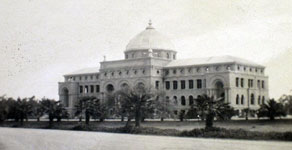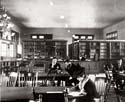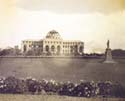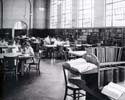|
Gallery | Campus Structures | Library
“A great library is the most important element in the formation of a great University,” wrote President David Starr Jordan. Leland Stanford, on the other hand, thought the library should be respectable and utilitarian, but modest in its holdings. When the university opened in October 1891, the library was located in Building 1 of the Inner Quadrangle and limited to three thousand quickly acquired volumes. The collection more than doubled in size the first year and continued to grow by about 5,500 volumes a year thereafter.
In 1900, the library moved to different quarters on the Outer Quadrangle. The newly constructed Thomas Welton Stanford Library was named for Leland Stanford’s younger brother, who donated funds for the building. The transfer of the collection from Building 1 was said to have taken staff and 250 student volunteers a mere ninety minutes to complete. Almost immediately, Jane Stanford announced plans for a larger and grander library, to be built north and east of the Main Quad. Like the Men’s Gymnasium and Chemistry Building, it was situated near Palm Drive, and violated Frederick Law Olmsted’s original plan for multiple quadrangles radiating east and west from the Main Quad.
The architectural style of the buildings erected by Jane outside the Quad was also a dramatic shift away from that of the original university buildings. Mrs. Stanford held a design competition for the new library and chose the submission of Joseph MacKay, a San Francisco art glassmaker. Combining both classical and Romanesque elements, the library’s exterior was an imposing structure that held its own with the other buildings Jane had commissioned. It was three stories high and included a basement. The large central rotunda, capped by a tall dome, was the centerpiece of the interior. Work began in June 1904, contracts for its completion were signed before Jane’s death in February 1905, and the building was largely finished by summer 1905. Unfortunately, librarians were not consulted during the design process, and the floor plan was unsuitable for use, and fire protection for the books was inadequate. Structural problems were also discovered. As the university trustees moved to correct these, the earthquake hit and the effect was utter ruin. The dome of the library stood as if on stilts, with the rest of the building disintegrated around it. Little of the former grandeur remained.
In 1919, Stanford opened its new Library, located to the east of the Main Quadrangle, as the replacement for the library demolished by the 1906 quake. Designed by the San Francisco architectural firm, Bakewell and Brown, the Beaux Arts building was a steel frame construction, incorporating hollow clay-tile walls and reinforced concrete. Badly shaken eighty years after its opening, Green Library West required a major structural redesign. Seismically strengthened and completely refurbished, the Bing Wing, named to honor donors Peter and Helen Bing, reopened in October 1999. Learn more about the Green Library Bing Wing on the Walking Tour.
Digital images from the Stanford University Archives represented on this site may be viewed freely. These images may not be reproduced or used for any purpose without permission. For permission requests please contact the Office of the University Archivist
Questions or comments? Email the Web Manager
|







































